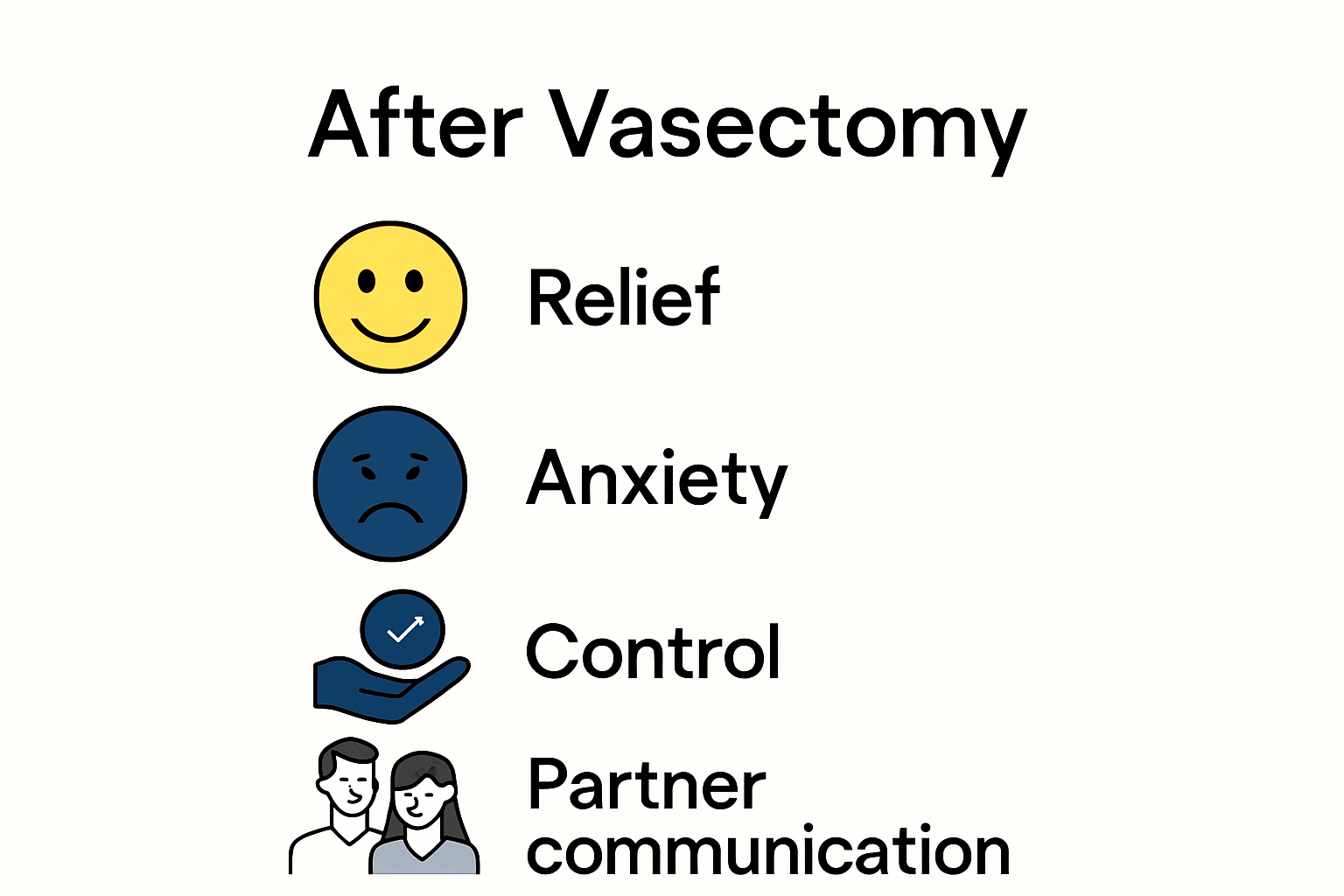Vasectomy is often seen as a quick fix for permanent birth control, but there is a hidden catch. It typically takes about 10 weeks and at least 32 ejaculations for most men to reach sperm-free semen. Think the operation ends your worries overnight? Think again. Until a lab confirms you are truly clear, your chances of causing a pregnancy remain, no matter how routine the recovery feels. Here is what really matters when it comes to sperm clearance after vasectomy in 2025.
Table of Contents
- Understanding Sperm Clearance After Vasectomy
- Factors Affecting Sperm Clearance Timelines
- Confirming Successful Sperm Clearance
- Life After Vasectomy: Key Considerations
Quick Summary
| Takeaway | Explanation |
|---|---|
| Post-vasectomy sperm clearance takes time. | Achieving complete sterility can vary significantly among individuals, requiring multiple ejaculations and patience. It typically takes about 10 weeks and at least 32 ejaculations for many men to achieve sperm-free semen. |
| Semen analysis is essential for confirmation. | Multiple semen analyses are necessary to verify successful sperm clearance. Patients should continue using alternative contraception until confirmed azoospermia (absence of sperm) is achieved through testing. |
| Individual factors affect clearance timelines. | Factors such as age, surgical technique, anatomical variations, and lifestyle play a crucial role in determining how quickly sperm can be cleared from the reproductive system. |
| Communication with healthcare providers is key. | Open dialogue with urologists about follow-up appointments and testing is essential for ensuring effective post-vasectomy care and addressing individual concerns. |
| Psychological considerations are important. | Men may experience a range of emotions post-vasectomy; discussing expectations and feelings with partners can support better understanding and adjustment to this permanent decision. |
Understanding Sperm Clearance After Vasectomy
A vasectomy is a permanent male contraception procedure that interrupts sperm transport, but achieving complete sterility is not instantaneous. Post vasectomy sperm clearance is a critical phase where remaining sperm gradually exit the reproductive system, requiring careful monitoring and follow-up testing.
How Sperm Clearance Works After Vasectomy
When a vasectomy is performed, the vas deferens are surgically cut or sealed, preventing sperm from mixing with semen. However, existing sperm remain stored in the reproductive tract and continue to be produced initially. Sperm clearance is the process of eliminating these residual sperm through repeated ejaculations.
According to research, post-vasectomy semen analysis studies recommend initial testing between 6 to 18 weeks after the procedure. During this period, patients must continue using alternative contraception, as sperm can remain viable in the reproductive system.
Research indicates that sperm clearance varies significantly among individuals. At 12 weeks post-procedure, approximately 63% of patients produced sperm-free semen, while 13% still contained multiple million sperm per milliliter. This variability underscores the importance of comprehensive post vasectomy testing.
The Importance of Semen Analysis
Post vasectomy semen analysis is crucial for confirming successful sperm clearance. This diagnostic test examines semen samples to determine the presence and quantity of sperm. Urological experts recommend continued contraception until the analysis confirms azoospermia (absence of sperm) or reveals only rare, non-motile sperm.
Typically, patients require multiple semen analyses to verify complete sperm clearance. The median time to achieve sperm-free semen is approximately 10 weeks and 32 ejaculations. However, individual experiences can differ based on factors like metabolism, reproductive tract anatomy, and healing processes.
Factors Affecting Sperm Clearance
Several factors influence the duration and effectiveness of post vasectomy sperm clearance. Age, overall health, surgical technique, and individual biological variations can impact how quickly sperm are eliminated from the reproductive system.
Patients should maintain open communication with their urologist, attend scheduled follow-up appointments, and strictly adhere to post-procedure guidelines. Consistent semen analysis helps ensure contraceptive reliability and provides peace of mind during the sperm clearance process.
Understanding and patience are key. While the vasectomy procedure itself is quick, achieving complete sterility requires time, multiple ejaculations, and professional medical verification through comprehensive semen analysis.
Factors Affecting Sperm Clearance Timelines
 Sperm clearance after a vasectomy is not a uniform process and varies widely among individuals. Understanding the complex factors influencing post vasectomy sperm clearance helps patients set realistic expectations and ensure effective contraception.
Sperm clearance after a vasectomy is not a uniform process and varies widely among individuals. Understanding the complex factors influencing post vasectomy sperm clearance helps patients set realistic expectations and ensure effective contraception.
Individual Physiological Variations
Each man’s reproductive system responds differently to a vasectomy. Factors such as age, overall health, hormonal balance, and genetic predispositions play significant roles in determining sperm clearance timelines. Urological research suggests that metabolic rate, reproductive tract anatomy, and individual healing processes contribute to the variability in sperm elimination.
Younger men typically experience faster sperm clearance compared to older patients. Testosterone levels, overall physical fitness, and immune system responses can accelerate or slow down the process of removing residual sperm from the reproductive tract.
Surgical Technique and Individual Anatomy
The specific vasectomy procedure and the surgeon’s technique significantly impact sperm clearance timelines. Surgical approaches such as traditional cut-and-tie, cauterization, or newer minimally invasive techniques can influence how quickly sperm are prevented from mixing with semen.
Anatomical differences between individuals mean that some men may have more complex reproductive tract structures. Variations in vas deferens length, diameter, and positioning can affect how quickly sperm are cleared from the system. These anatomical nuances explain why some patients achieve post vasectomy sperm clearance more rapidly than others.
Lifestyle and Compliance Factors
Patient behavior and lifestyle choices play a crucial role in effective sperm clearance. Medical studies recommend initial post-vasectomy semen analysis between 6 to 18 weeks after the procedure, with compliance being a key determinant of successful contraception.
Factors that can impact sperm clearance include:
- Frequency of ejaculation
- Overall health and fitness levels
- Adherence to post-procedure guidelines
- Stress levels and overall physical condition
- Consistency in follow-up medical appointments
Patients who follow medical advice closely, maintain regular follow-up testing, and understand the importance of continued contraception until confirmed sterility are more likely to achieve optimal post vasectomy testing results.
It is critical to recognize that sperm can remain viable in the reproductive system for several months after the procedure. Urological experts emphasize the importance of continued contraception and multiple semen analyses to ensure complete sperm clearance.
Each patient’s journey to confirmed sterility is unique. Open communication with healthcare providers, patience, and strict adherence to medical guidance are essential in navigating the post-vasectomy sperm clearance process successfully.
Confirming Successful Sperm Clearance
Confirming successful post vasectomy sperm clearance is a critical step in ensuring the effectiveness of male contraception. The process requires systematic testing, patient cooperation, and precise medical evaluation to guarantee complete sterility.
Semen Analysis Protocol
Clinical guidelines recommend a comprehensive approach to verifying sperm clearance. The standard protocol involves collecting semen samples at specific intervals following the vasectomy procedure to determine the absence of sperm.
A recent 2024 study revealed fascinating insights into post vasectomy testing. Research findings demonstrated that post-vasectomy semen analysis clearance (PVSAC) was achieved at a median of 5.7 weeks, with an initial clearance rate of 74.6%. However, approximately 1.5% of patients may still have persistent sperm, underscoring the importance of thorough follow-up testing.
Timing and Number of Semen Analyses
Successful sperm clearance confirmation typically requires multiple strategic steps. Urological experts recommend the following testing parameters:
- First analysis: Conducted at least 12 weeks after the vasectomy
- Minimum number of ejaculations before testing: 20
- Confirmed clearance: Detection of zero sperm (azoospermic sample)
Patients must continue using alternative contraception until a healthcare professional definitively confirms complete sperm elimination. The vasectomy semen analysis serves as the ultimate verification of contraceptive success.
Interpretation of Semen Analysis Results
Interpreting post-vasectomy semen analysis results requires professional medical expertise. Urologists examine the sample for several key indicators:
- Presence or absence of sperm
- Sperm motility
- Concentration of remaining sperm
- Potential signs of recanalization
If the initial analysis shows any remaining sperm, additional testing and potential intervention might be necessary. Medical professionals emphasize that even a small number of sperm can potentially lead to pregnancy.
Interestingly, while most men achieve successful sperm clearance within 3-4 months, individual variations can extend this timeline. Patients should maintain open communication with their healthcare provider and strictly adhere to recommended follow-up schedules.
The journey to confirmed sterility requires patience, precision, and a comprehensive approach. By understanding the intricacies of post vasectomy sperm clearance, men can confidently navigate this important phase of reproductive health management.
Life After Vasectomy: Key Considerations
A vasectomy represents a significant life decision with implications beyond the surgical procedure. Understanding the physical, emotional, and practical aspects of life after vasectomy helps men navigate this important reproductive health milestone.
Physical Recovery and Sexual Health
Medical research indicates that physical recovery from vasectomy is typically straightforward. Most men experience minimal discomfort and can return to normal activities within a few days. However, understanding the nuanced recovery process is crucial for optimal healing and long-term sexual health.
Initial post-procedure recommendations include:
- Limited physical activity for 48-72 hours
- Using supportive underwear to minimize movement
- Applying ice packs to reduce swelling
- Avoiding heavy lifting and strenuous exercise
Contrary to common misconceptions, a vasectomy does not impact sexual function, testosterone levels, or sexual pleasure. Urological experts confirm that men maintain normal hormonal production and sexual performance after the procedure.
Psychological and Relationship Considerations
 The decision to undergo a vasectomy often involves complex emotional and relational dynamics. Open communication with partners becomes paramount in addressing potential concerns about fertility, masculinity, and future family planning.
The decision to undergo a vasectomy often involves complex emotional and relational dynamics. Open communication with partners becomes paramount in addressing potential concerns about fertility, masculinity, and future family planning.
Psychological studies suggest that men may experience a range of emotions, including:
- Relief from contraceptive responsibilities
- Potential anxiety about permanent reproductive changes
- Sense of taking reproductive health control
- Concerns about sexual identity
Couples are encouraged to discuss expectations, future family planning, and emotional responses to the procedure. Professional counseling can help navigate any psychological challenges associated with this significant reproductive decision.
Long-Term Health and Monitoring
While a vasectomy is considered a permanent contraceptive solution, ongoing health monitoring remains important. Medical guidelines recommend periodic check-ups to ensure continued reproductive health and address any potential late-onset complications.
Key long-term considerations include:
- Annual reproductive health screenings
- Monitoring for rare potential complications
- Maintaining open communication with healthcare providers
- Understanding that reversal procedures are complex and not always successful
Interestingly, some studies suggest potential health benefits associated with vasectomy, including reduced risks of certain prostate conditions. However, individual health experiences can vary, emphasizing the importance of personalized medical guidance.
Life after vasectomy represents a proactive approach to reproductive health and family planning. By understanding physical recovery, addressing psychological aspects, and maintaining ongoing health monitoring, men can confidently embrace this transformative reproductive choice.
Remember, each individual’s experience is unique. Patience, open communication, and professional medical guidance are essential in navigating the post-vasectomy journey successfully.
Frequently Asked Questions
How long does it take for sperm to clear after a vasectomy?
It typically takes about 10 weeks and at least 32 ejaculations for most men to achieve sperm-free semen after a vasectomy.
What is the importance of semen analysis after a vasectomy?
Semen analysis is crucial for confirming successful sperm clearance. Patients should continue using alternative contraception until tests confirm azoospermia (absence of sperm).
What factors can affect the timeline for sperm clearance?
Individual factors such as age, surgical technique, anatomy, and lifestyle can impact how quickly sperm are cleared from the reproductive system after a vasectomy.
Do I need to follow up with my healthcare provider after a vasectomy?
Yes, open communication with your healthcare provider and attending scheduled follow-up appointments are essential for monitoring sperm clearance and ensuring effective post-vasectomy care.





